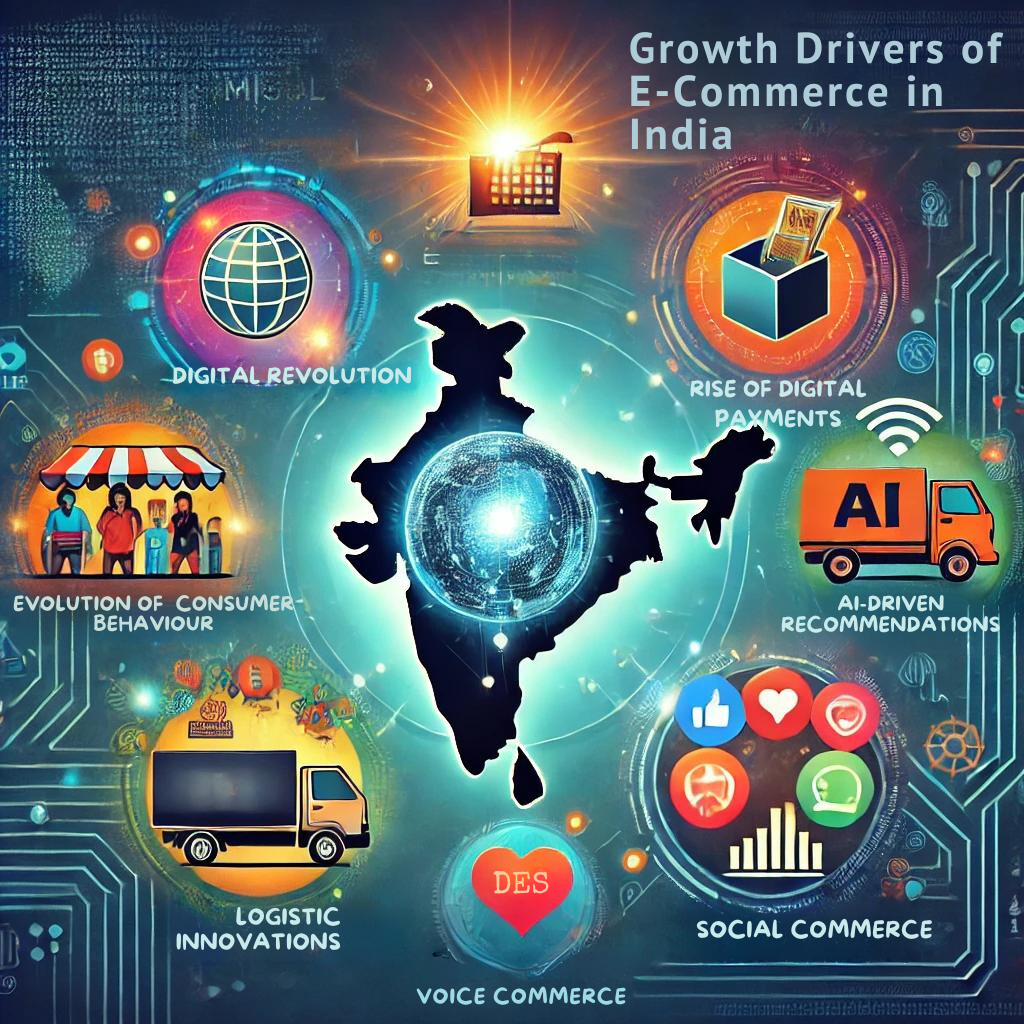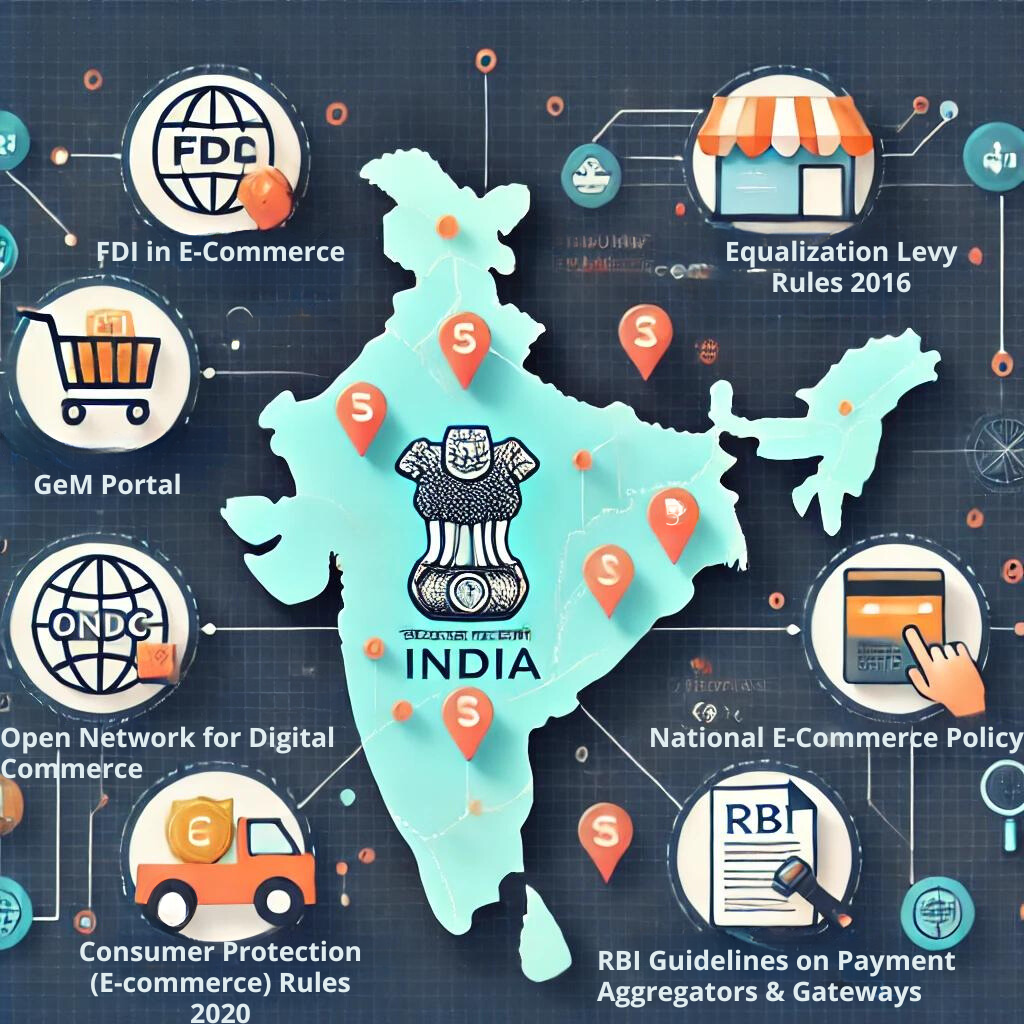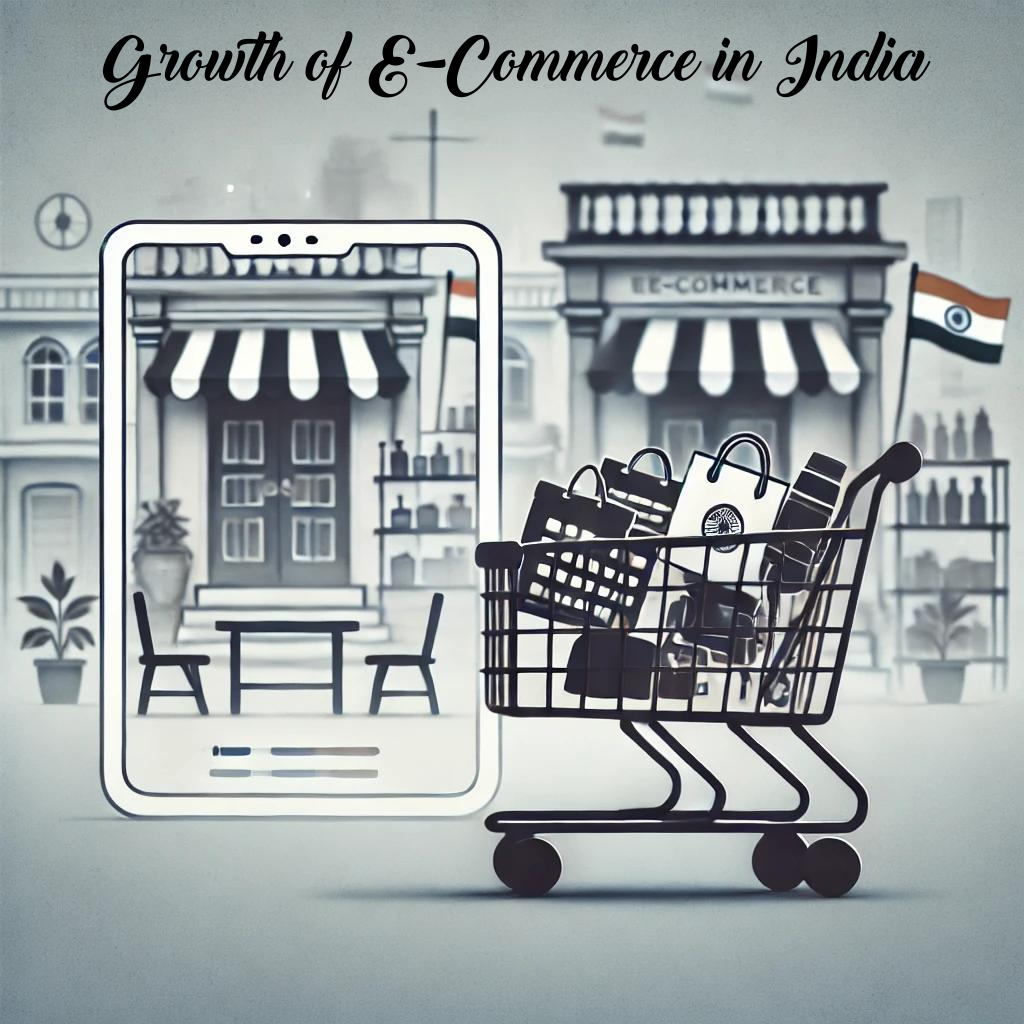The Indian e-commerce industry is growing rapidly, projected to reach USD 350 billion by 2030. This growth has sparked debates about its impact on traditional retail. While e-commerce empowers consumers and small businesses, concerns about its potential disruption to traditional retail persist. The government’s previous support for the sector contrasts with recent worries voiced by India’s Commerce Minister.
E-commerce offers consumers a wider range of choices, efficient delivery systems, and better return policies. It has improved access to products in smaller towns and enhanced logistics infrastructure. Small businesses are adapting by leveraging online platforms, leading to increased sales and employment opportunities. E-commerce has disrupted traditional distribution models, enabling smaller Indian brands to compete more effectively with established players. This evolving landscape promotes a consumer-centric market, reducing the likelihood of predatory practices taking root.
| GS Paper | General Studies III |
| Topics for UPSC Prelims | Indian e-commerce industry, Open Network for Digital Commerce, Unified Payment Interface, BHIM, Competition Commission of India, Gig Economy, Foreign Direct Investment, Equalization Levy Rules 2016, Social-Ecommerce, RBI Guidelines on Payment Aggregators and Gateways. |
| Topics for UPSC Mains | Major Growth Drivers of E-commerce in India, Major Issues Related to the E-Commerce Sector in India. |
Origin of the Article
This editorial is based on “E-commerce has done more good than harm,” published in Hindu Business Line on 25/08/2024. The article discusses the rapid growth of India’s e-commerce sector and its implications for traditional retail.
Relevancy for UPSC Students
For UPSC students, understanding the dynamics of India’s e-commerce sector is crucial. It aligns with GS Paper 3 of the UPSC syllabus, covering topics like Industrial Growth, Industrial Policy, and Capital Market. This knowledge is essential for answering questions related to the economy, technology, and commerce.
Why in News
The rapid growth of India’s e-commerce industry has recently garnered attention due to its dual impact on consumers and traditional retail. This topic is crucial for the UPSC Civil Services exam as it intersects with issues of economic growth, consumer rights, and small business sustainability—key areas previously explored in GS Paper 3 questions on industrial growth and policy.
Navigating India’s E-commerce Crossroads
The Indian e-commerce industry is experiencing rapid growth, with projections estimating it will reach USD 350 billion by 2030. However, this expansion has sparked significant debate. Recently, India’s Commerce Minister has expressed concerns that the rise of e-commerce could disrupt traditional retail, potentially harming small businesses, a concern that may seem belated given the government’s previous support for the sector.
Conversely, e-commerce has empowered consumers by offering a wider range of choices, efficient delivery systems, and improved return policies. It has also enhanced access to products in smaller towns and strengthened logistics infrastructure. Many small businesses are adapting by leveraging online platforms, leading to increased sales and employment opportunities. E-commerce has disrupted traditional distribution models, enabling smaller Indian brands to compete more effectively with established players. This evolving landscape promotes a consumer-centric market, reducing the likelihood of predatory practices taking root.
What is E-Commerce?
E-commerce, short for electronic commerce, refers to the buying and selling of goods or services using the internet and the transfer of money and data to execute these transactions. It has significantly transformed the digital marketplace, creating new opportunities and challenges for businesses and consumers alike.
About
E-commerce is crucial in today’s economic scenario, as it facilitates seamless transactions, expands market reach, and enhances consumer convenience. By leveraging digital platforms, businesses can operate beyond geographical limitations, tapping into a global customer base.
Types of E-Commerce
- Business-to-Consumer (B2C): Companies like Amazon sell products directly to consumers, revolutionizing retail by offering a vast selection and competitive pricing.
- Business-to-Business (B2B): Wholesalers utilize online platforms to sell to retailers, streamlining supply chains and improving efficiency.
- Consumer-to-Consumer (C2C): Platforms like eBay and OLX enable individuals to sell to each other, creating a vibrant marketplace for used and unique items.
- Consumer-to-Business (C2B): Freelancers offer services on platforms like Upwork, allowing businesses to access a diverse pool of talent.
- Business-to-Government (B2G): Companies bid for government contracts online, promoting transparency and efficiency in public procurement.
- Social Commerce: E-commerce through social media platforms like Facebook Marketplace has gained traction, leveraging social networks for sales.
- Mobile Commerce (M-Commerce): Transactions conducted via mobile devices have surged, driven by the ubiquity of smartphones.
- Local Commerce: Online platforms like Nextdoor connect local buyers and sellers, fostering community-based commerce.
What are the Major Growth Drivers of E-commerce in India?
India’s e-commerce sector is booming, driven by several key factors that have transformed the digital landscape and consumer behavior.

Digital Revolution-Smartphones and Internet Penetration
India will have 1 billion smartphone users by 2026, with rural areas driving the sale of internet-enabled phones. The average cost of 1 GB of mobile internet data in India is among the lowest globally, at just Rs 13.98. This digital accessibility has made online shopping a reality for millions, especially in Tier 2 and 3 cities.
Rise of Digital Payments-UPI and Beyond
The surge in digital payments has been a key enabler for e-commerce. Unified Payment Interface (UPI) transactions hit a new high in May 2024, processing 14.04 billion transactions worth Rs 20.45 trillion. The ease of digital transactions, coupled with initiatives like BHIM, has reduced reliance on cash-on-delivery.
Evolving Consumer Behavior-Convenience and Choice
Changing lifestyles and increasing time scarcity have tilted consumer preferences towards the convenience of online shopping. E-commerce platforms offer unparalleled product variety, with Amazon India listing over 170 million products. This vast selection, combined with competitive pricing and doorstep delivery, has made e-commerce an attractive option for urban and rural consumers alike.
Logistics and Last-Mile Delivery Innovation
Improvements in logistics have been pivotal for e-commerce expansion. India’s logistics market, valued at USD 250 billion in 2021, is expected to grow to USD 380 billion by 2025. E-commerce-focused logistics players like Delhivery and Ecom Express have revolutionized last-mile delivery, with innovations like hyperlocal delivery reducing delivery times to as little as 10-30 minutes in some cities.
Rise of Social Commerce and Live Shopping
Social commerce is emerging as a significant trend, blending social media with e-commerce. Platforms like Meesho have tapped into the power of social networks for product discovery and sales. Live shopping, popularized by platforms like Flipkart’s Shopsy and YouTube’s integrated shopping features, is expected to be a USD 4-5 billion market in India by 2025.
Personalization and AI-Driven Recommendations
Advanced data analytics and AI are enhancing the online shopping experience through personalization. E-commerce giants like Amazon report that 35% of their sales come from personalized recommendations. AI-powered chatbots handle 30-40% of customer queries on major platforms, improving customer satisfaction and driving higher conversion rates.
Regular Approach and Voice Commerce
Providing for India’s linguistic diversity has opened up new e-commerce markets. Voice-based shopping, supported by platforms like Amazon’s Alexa and Google Assistant, is gaining traction. According to a report by the Internet and Mobile Association of India, 57% of Internet users prefer to access the Internet in Indian languages, presenting a massive opportunity for voice and vernacular e-commerce solutions.
What are Major Issues Related to E-Commerce Sector in India?
Despite its rapid growth, the e-commerce sector in India faces several significant challenges that need to be addressed to ensure sustainable development.
Excessive High Pricing
Allegations of very high pricing have powered major e-commerce players. In 2020, the Competition Commission of India (CCI) ordered a probe into Amazon and Flipkart for deep discounting practices. While beneficial for consumers in the short term, this practice raises concerns about long-term market health and fair competition.
Data Privacy
As e-commerce platforms collect vast amounts of user data for personalized experiences, concerns about data privacy and security have intensified. High-profile data breaches, like the alleged Domino’s India breach affecting 180 million orders in 2021, underscore the risks. Balancing personalization with privacy remains a significant challenge.
Counterfeit Problems
The proliferation of counterfeit products on e-commerce platforms poses a major threat to brand integrity and consumer trust. A 2018 LocalCircles survey found that 38% of consumers had received fake products from e-commerce sites. The challenge lies in effectively policing millions of listings without stifling legitimate sellers.
The Small Retailer Squeeze
The rapid growth of e-commerce giants has put immense pressure on India’s 63 million small retailers. Government initiatives like Open Network for Digital Commerce (ONDC) aim to level the playing field, but small retailers still struggle to match the tech prowess and economies of scale of e-commerce behemoths.
Last-Mile Logistics
Reaching India’s vast rural population remains challenging. Poor road infrastructure, lack of proper addresses, and limited warehousing facilities in remote areas inflate delivery costs. Innovations like Amazon’s I Have Space program and Flipkart’s partnership with Kiranas have helped, but reaching the last mile profitably remains formidable.
The Environmental Cost of Convenience
The e-commerce boom has raised significant environmental concerns. The packaging waste generated by online orders is staggering. India generated 3.4 million tonnes of plastic waste in 2019-20, with e-commerce being a major contributor. The carbon footprint of last-mile deliveries, especially with the rise of quick commerce, is substantial.
The Gig Economy Grapple
The e-commerce boom has fueled the growth of the gig economy, particularly in logistics and delivery services. While offering flexible employment, quick commerce has raised concerns about worker rights, job security, and safety. Gig workers cannot typically unionize or collectively bargain for better working conditions and remuneration.
The Influencer Impact
The growing role of influencer marketing in e-commerce has raised concerns about authenticity and disclosure. Issues of undisclosed paid partnerships and misleading product endorsements have come under scrutiny. Balancing the power of influencer marketing with maintaining consumer trust and regulatory compliance presents an ongoing challenge.
What are Government Initiatives Related to E-Commerce Sector in India?
The Indian government has introduced several initiatives to regulate and promote the e-commerce sector, ensuring its sustainable growth and fair practices.
Foreign Direct Investment (FDI) in E-Commerce
The government has allowed 100% FDI in the e-commerce marketplace model, particularly in B2B transactions. This policy aims to attract foreign investment and enhance the sector’s growth.
Government e-Marketplace (GeM) Portal
Launched in August 2016, the GeM portal promotes transparent and efficient public procurement, with procurement crossing ₹2 lakh crore in FY23. It ensures fair competition and better pricing for government purchases.
Open Network for Digital Commerce (ONDC)
Introduced in 2022, ONDC aims to democratize e-commerce by providing equal opportunities for MSMEs to thrive in digital commerce. It seeks to create a level playing field for small retailers.
Consumer Protection (E-commerce) Rules 2020
These rules mandate e-commerce platforms to display the country of origin and disclose product listing parameters to ensure transparency for consumers. They aim to protect consumer interests and promote fair practices.
Equalization Levy Rules 2016 (Amended in 2020)
These rules impose a 2% tax on foreign e-commerce operators selling goods or services in India, ensuring fair taxation of digital businesses and addressing the issue of tax avoidance.
RBI Guidelines on Payment Aggregators and Gateways
In 2020, the Reserve Bank of India issued guidelines for payment aggregators and gateways, crucial for e-commerce transactions. These guidelines mandate licensing for payment aggregators and enhance customer grievance redressal mechanisms.
National E-Commerce Policy
The forthcoming National E-Commerce Policy seeks to enhance sector growth and boost exports. It aims to provide clear guidelines on FDI, data localization, and cross-border trade, ensuring a comprehensive regulatory framework.

Measures E-Commerce Sector in India Must Adopt
To address the challenges and ensure balanced growth, several measures can be adopted to support the e-commerce sector in India.
Leveling the Playing Field of Small Retailers
Launch a nationwide “Digital Kirana” initiative to equip small retailers with digital tools and skills. Partner with established e-commerce players to create dedicated “local seller” sections on their platforms, highlighting nearby small businesses.
ONDC Acceleration
Fast-track the implementation of the ONDC initiative across all major cities. Provide financial incentives for early adopters, both sellers and technology providers, to boost participation. Launch a nationwide awareness campaign to educate consumers and businesses about ONDC’s benefits.
Streamlining the E-commerce Ecosystem
Formulate a comprehensive, forward-looking e-commerce policy that provides clear guidelines on FDI, data localization, and cross-border trade. Establish a dedicated e-commerce regulatory body to oversee compliance and promote fair competition.
Last-Mile Innovation Fund
Create a government-backed “Last-Mile Innovation Fund” to support startups and existing players in developing cost-effective rural delivery solutions. Offer tax incentives for companies investing in rural logistics infrastructure.
Green E-commerce Push
Implement a mandatory “Green Rating” system for e-commerce packaging, incentivizing the use of eco-friendly materials. Introduce tax benefits for e-commerce companies adopting electric vehicles for last-mile delivery.
Consumer Protection Enhancement
Strengthen the e-commerce dispute resolution mechanism by establishing dedicated online consumer courts for faster grievance redressal. Implement a blockchain-based product verification system to combat counterfeits.
Inclusive Gig Economy Framework
Develop a comprehensive social security scheme for e-commerce gig workers, including health insurance and retirement benefits. Implement a “Portable Benefits” system allowing gig workers to accumulate benefits across multiple platforms.
PESTEL Analysis
| Political: India’s e-commerce is significantly influenced by government policies such as 100% FDI in B2B e-commerce, the implementation of the National E-Commerce Policy, and the promotion of the Government e-marketplace (GeM). Regulatory initiatives like the Consumer Protection Rules 2020 and the Equalization Levy on foreign e-commerce operators shape operational dynamics. Economic: The sector is poised to reach $350 billion by 2030, driven by high mobile penetration and digital payment systems like UPI. However, issues such as predatory pricing and economic disparities in access to e-commerce between urban and rural areas pose challenges. Social: E-commerce has transformed consumer behavior, offering convenience and a broader product range. There is growing acceptance of social commerce and live shopping, especially among younger consumers. However, there’s an ongoing concern regarding the impact on small retailers and the proliferation of counterfeit products. Technological: Advances in AI for personalized shopping, robust digital payment infrastructures, and the adoption of mobile commerce are pivotal. The sector’s growth is further supported by innovations in logistics and last-mile delivery, although gaps in rural infrastructure remain. Environmental: E-commerce’s environmental impact includes increased packaging waste and emissions from deliveries. Initiatives are needed to promote sustainable practices, such as greener packaging and the use of electric delivery vehicles. Legal: The sector is guided by stringent rules on data privacy, FDI, and consumer rights, requiring e-commerce platforms to maintain transparency and adhere to local laws. There are also legal challenges related to gig worker rights and job security within the e-commerce delivery networks. |
Conclusion
India’s e-commerce sector stands at a crucial moment, reflecting both vast opportunities and significant challenges. While it has undeniably empowered consumers and small businesses, the potential disruptions to traditional retail cannot be overlooked. For UPSC aspirants, understanding this dynamic landscape is essential, as it underscores the broader themes of economic transformation and regulatory balancing. Future administrators must advocate for policies that foster innovation while ensuring inclusive growth and fair competition.
| UPSC Civil Services Examination, Previous Year Questions (PYQs) Mains Q. E-commerce has been seen as a double-edged sword in India, empowering consumers while also threatening traditional businesses. Discuss the major opportunities and challenges posed by the e-commerce sector in India. (GS Paper III, 2022) Q. The Unified Payments Interface (UPI) has revolutionized digital payments in India. Analyze the impact of UPI on the growth of the e-commerce industry and the challenges it faces in terms of cybersecurity and data privacy. |



